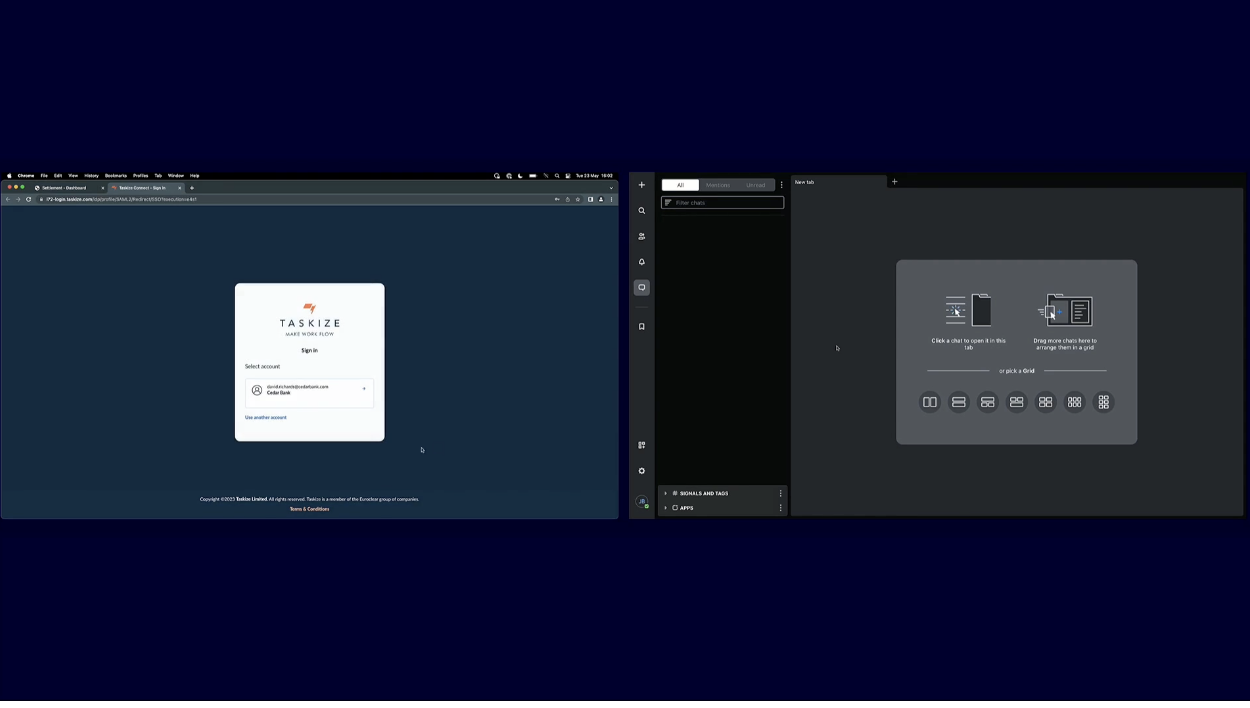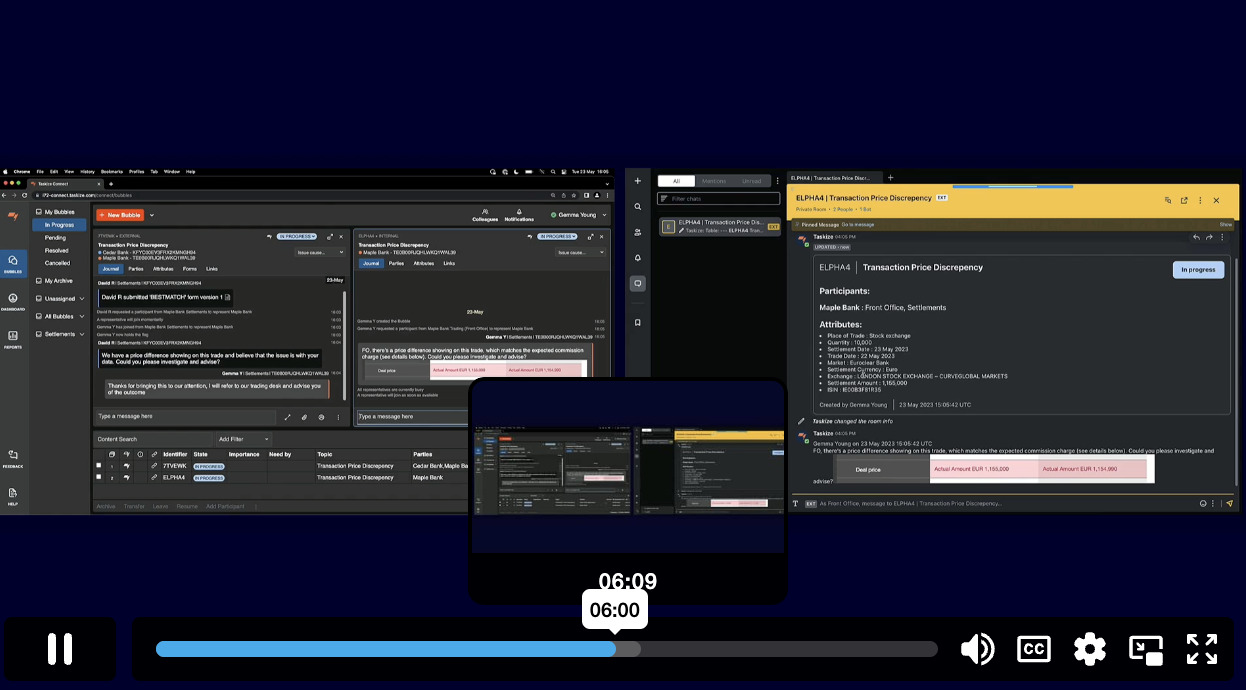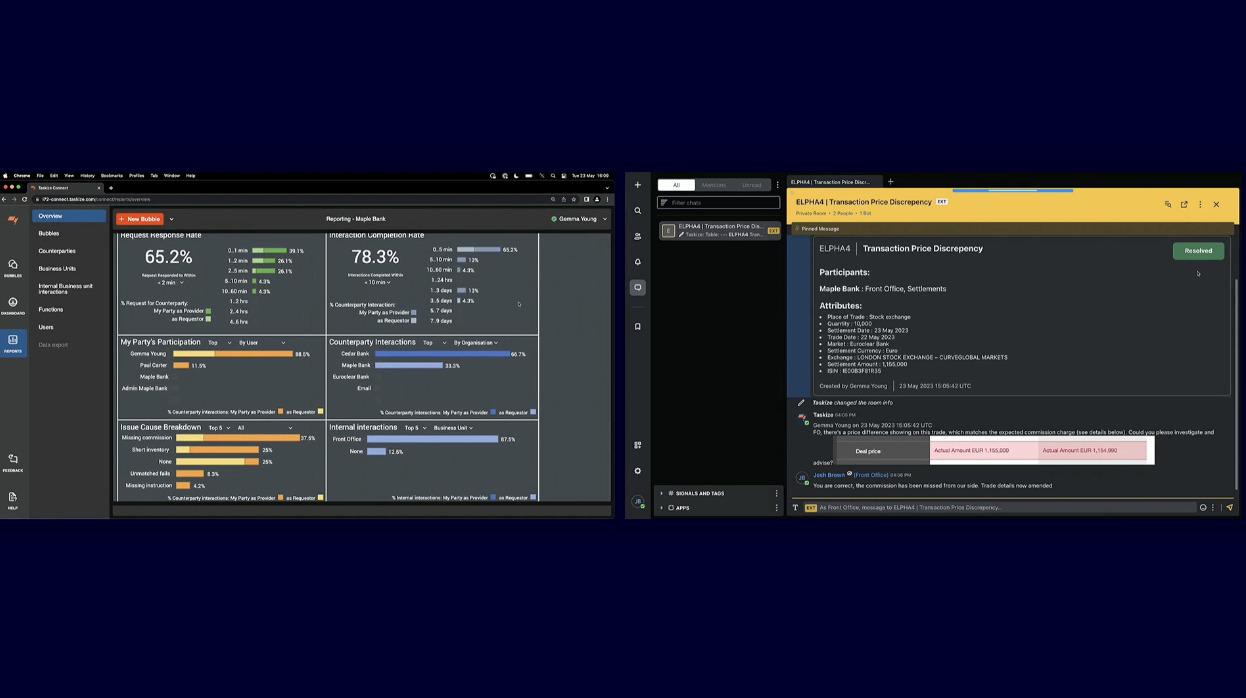Press releases
Euroclear teams with Meritsoft and Taskize to launch next generation AI service
Read the press release
How can you resolve 1 post-trade issue between 2 counterparties, across 3 systems in just 7 minutes? Watch our on-demand demo of seamless interoperability between Symphony, Euroclear EasyWay and Taskize.
How can you resolve 1 post-trade issue between 2 counterparties, across 3 systems – live on stage! – in just 7 minutes? Watch our on-demand demo of seamless interoperability between Symphony, Euroclear EasyWay and Taskize.
Our presenter and Head of Product, Kishan Bharwad is your guide, working with three typical user personas…
“We’re going to show you interoperability in action. We all know that connected platforms can increase efficiencies, but what does that look like in a real-life scenario and what are the benefits? We’ve got a scenario here, a common scenario that’s seen across the industry:
“Here’s the Euroclear EasyWay dashboard. This is where David from Cedar Bank can see all his exceptions. And it looks like there’s a unmatched settlement instruction that needs to be resolved by 2:00 PM today, so pretty urgent. He’s going to select that particular settlements break and it’s going to highlight in red here that it’s as a result of a price discrepancy. So this needs to now be resolved. And Cedar Bank use Taskize to resolve their issues, and Euroclear and Taskize have an integration that allows that to be executed quite seamlessly. Oftentimes the biggest problems can be caused by some of the smallest issues such as wreaking data in different systems, copying and pasting information from one platform to another.
“So the first benefit of interoperability that we have here is the seamless transfer of data from EasyWay. The exception details get transferred directly onto the Taskize Bubble in one click. So now you have all the exception details, this problem ticket is now ready to be resolved. Let me take you through the interface very quickly. On the right-hand side here we have the Taskize Bubble, which is where the issue resolution is going to take place. And on the left-hand side here we have what we call our bubble blotter, so this is where David can manage and prioritize all of his tasks.

“So going back to the Taskize Bubble, David is going to invite the counterparty, Maple Bank, to resolve the issue and that’s going to be done using the Taskize Smart Directory. The Smart Directory is designed to help solve the problem for Cedar Bank to help navigate their industry. Often, you don’t know who to contact and you don’t know which team you need to send the request to. That’s the first problem the Smart Directory solves. And the second problem is on Maple Bank’s side, who does that need to be allocated to? It’s often quite difficult to manage who’s the right person to solve the issue.
“The first thing that David does is he selects the organization that he wants to send the request to, in this case Maple Bank, and then selects the function he wishes to send the request to, which is settlements. And that’s all he needs to do. When he clicks add, what happened just there very quickly was the Smart Directory in action. So it took the exception details from EasyWay, it matched that against the responsibilities of the settlements team at Maple Bank. It found the most experienced person based on having resolved those issues before and who was the most appropriate person based on capacity. So it took all those factors into account to then assign the issue to Gemma from Maple Bank. So the audit trail there is intact and shows that Gemma’s now joined the bubble to resolve the issue.
“David’s going to communicate to Gemma and let her know that there’s a price discrepancy on this trade and he believes that the issue’s on Maple Bank’s side. So he is going to send that message. And now we’re going to switch to Gemma’s view. So now we’re from the perspective of Gemma. Gemma is going to communicate to David that she believes that she needs to refer to her trading desk to clarify the problem. So she’s going to get back to David shortly. In order to contact the front office, she’s going to use what we call a linked bubble. So a linked bubble, it allows her to keep it separate from the client. She’s going to raise this, use this linked bubble to add a message to the front office team to let her know that she believes that this price discrepancy is as a result of the way the trade was booked.
“To enable this communication between the back office and the front office is where the Symphony integration comes in. So she’s going to select the internal business unit of front office. And when she clicks create, what’s going to happen is a room is going to be created in Symphony, which you see on the right-hand side here. Sorry, that request is going to create a room, it’s going to add those attributes that we saw earlier from Euroclear EasyWay, add it to the bubble and invite that front office team that’s responsible for this transaction.
“This is the second benefit of interoperability... Gemma didn’t even need to know that that front office team is using Symphony. So the integration between Taskize and Symphony allows two teams on two different platforms to communicate with one another while remaining in their platform of choice, so enabling that proximity without sacrificing the tools they prefer using. Gemma can begin resolving the resolution in Taskize. And Joshua, who is the person that booked the trade, remains on Symphony and can communicate back and forth between the two platforms seamlessly.

“It looks like Joshua, who’s in the front office team in this room, believes that the issue was as a result of commission that was missed from the transaction. So he’s going to add that to the bubble there and that’s going to be communicated to the bubble directly. I did actually miss off the fact that there are some other attributes that are being mapped across, such as the title for context and the status on the right-hand side here that you can see. The fact that this issue is in progress is communicated across both teams as well.
“Now that the issue has been resolved or at least been clarified, Gemma can resolve this bubble here that she has with her front office team. So you can see there, as the issue was updated and resolved, that was instantly communicated to the front office team on Symphony, so that they now know they don’t need to pay attention to this room, the issue’s been resolved. Gemma can now go back to the client on the original bubble and communicate the fact that the issue’s been resolved and it was as a result of a price discrepancy, sorry, a missing commission. She can then resolve that bubble. And then what Taskize allows you to do is add a root cause to the bubble. So she’s going to add a root cause element stating that it was as a result of a missing commission.
“So there you have it, one exception being resolved between two firms across three different platforms. We timed this issue resolution process and that took seven minutes 15 seconds. Now obviously, in reality, the communication probably wouldn’t happen as quick and maybe those source systems need to be updated, maybe take a little longer. But what we’re showcasing here is that interoperable technologies mean that the technology no longer needs to be the barrier. We’ve removed the friction so all that needs to happen is the communication and the people to get around the problem to resolve the issue, especially important on our journey towards T+1.

“Before we conclude the demo, there’s one final benefit of interoperability and that’s data and analytics. Because of the fact that the two systems were communicating using structured data between the three platforms, we get real actionable insights into the communication and collaboration that occurs specifically within the back office.
“So the Taskize reporting suite can show the makeup of the issue across your different counterparties, so which counterparties are causing you the most pain potentially, where the internal interactions are, so which teams are collaborating on resolving the issue, and earlier we added an attribute for missing commission and across our reporting, we can see that missing commission accounts for 37.5% of issues that resolved over Taskize.
“And that’s all because we have interoperable systems exchanging structured data between the two platforms and two firms.”